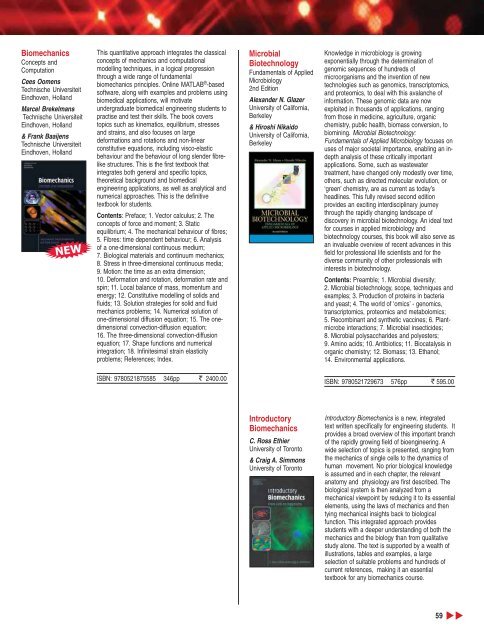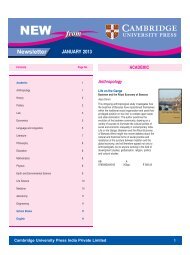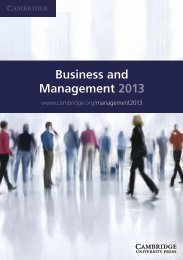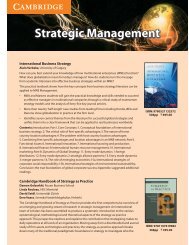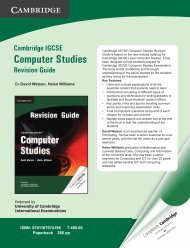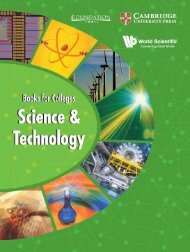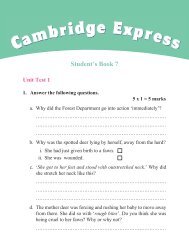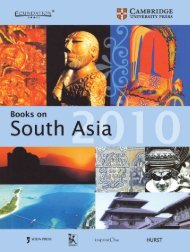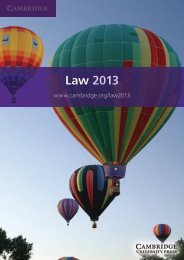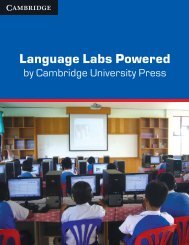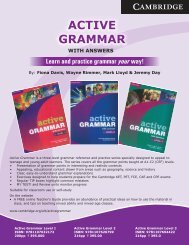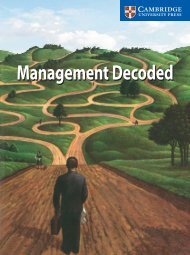ENGINEERING - Cambridge University Press India
ENGINEERING - Cambridge University Press India
ENGINEERING - Cambridge University Press India
You also want an ePaper? Increase the reach of your titles
YUMPU automatically turns print PDFs into web optimized ePapers that Google loves.
Biomechanics<br />
Concepts and<br />
Computation<br />
Cees Oomens<br />
Technische Universiteit<br />
Eindhoven, Holland<br />
Marcel Brekelmans<br />
Technische Universiteit<br />
Eindhoven, Holland<br />
& Frank Baaijens<br />
Technische Universiteit<br />
Eindhoven, Holland<br />
NEW<br />
This quantitative approach integrates the classical<br />
concepts of mechanics and computational<br />
modelling techniques, in a logical progression<br />
through a wide range of fundamental<br />
biomechanics principles. Online MATLAB ® -based<br />
software, along with examples and problems using<br />
biomedical applications, will motivate<br />
undergraduate biomedical engineering students to<br />
practise and test their skills. The book covers<br />
topics such as kinematics, equilibrium, stresses<br />
and strains, and also focuses on large<br />
deformations and rotations and non-linear<br />
constitutive equations, including visco-elastic<br />
behaviour and the behaviour of long slender fibrelike<br />
structures. This is the first textbook that<br />
integrates both general and specific topics,<br />
theoretical background and biomedical<br />
engineering applications, as well as analytical and<br />
numerical approaches. This is the definitive<br />
textbook for students.<br />
Contents: Preface; 1. Vector calculus; 2. The<br />
concepts of force and moment; 3. Static<br />
equilibrium; 4. The mechanical behaviour of fibres;<br />
5. Fibres: time dependent behaviour; 6. Analysis<br />
of a one-dimensional continuous medium;<br />
7. Biological materials and continuum mechanics;<br />
8. Stress in three-dimensional continuous media;<br />
9. Motion: the time as an extra dimension;<br />
10. Deformation and rotation, deformation rate and<br />
spin; 11. Local balance of mass, momentum and<br />
energy; 12. Constitutive modelling of solids and<br />
fluids; 13. Solution strategies for solid and fluid<br />
mechanics problems; 14. Numerical solution of<br />
one-dimensional diffusion equation; 15. The onedimensional<br />
convection-diffusion equation;<br />
16. The three-dimensional convection-diffusion<br />
equation; 17. Shape functions and numerical<br />
integration; 18. Infinitesimal strain elasticity<br />
problems; References; Index.<br />
Microbial<br />
Biotechnology<br />
Fundamentals of Applied<br />
Microbiology<br />
2nd Edition<br />
Alexander N. Glazer<br />
<strong>University</strong> of California,<br />
Berkeley<br />
& Hiroshi Nikaido<br />
<strong>University</strong> of California,<br />
Berkeley<br />
Knowledge in microbiology is growing<br />
exponentially through the determination of<br />
genomic sequences of hundreds of<br />
microorganisms and the invention of new<br />
technologies such as genomics, transcriptomics,<br />
and proteomics, to deal with this avalanche of<br />
information. These genomic data are now<br />
exploited in thousands of applications, ranging<br />
from those in medicine, agriculture, organic<br />
chemistry, public health, biomass conversion, to<br />
biomining. Microbial Biotechnology:<br />
Fundamentals of Applied Microbiology focuses on<br />
uses of major societal importance, enabling an indepth<br />
analysis of these critically important<br />
applications. Some, such as wastewater<br />
treatment, have changed only modestly over time,<br />
others, such as directed molecular evolution, or<br />
‘green’ chemistry, are as current as today’s<br />
headlines. This fully revised second edition<br />
provides an exciting interdisciplinary journey<br />
through the rapidly changing landscape of<br />
discovery in microbial biotechnology. An ideal text<br />
for courses in applied microbiology and<br />
biotechnology courses, this book will also serve as<br />
an invaluable overview of recent advances in this<br />
field for professional life scientists and for the<br />
diverse community of other professionals with<br />
interests in biotechnology.<br />
Contents: Preamble; 1. Microbial diversity;<br />
2. Microbial biotechnology, scope, techniques and<br />
examples; 3. Production of proteins in bacteria<br />
and yeast; 4. The world of ‘omics’ - genomics,<br />
transcriptomics, proteomics and metabolomics;<br />
5. Recombinant and synthetic vaccines; 6. Plantmicrobe<br />
interactions; 7. Microbial insecticides;<br />
8. Microbial polysaccharides and polyesters;<br />
9. Amino acids; 10. Antibiotics; 11. Biocatalysis in<br />
organic chemistry; 12. Biomass; 13. Ethanol;<br />
14. Environmental applications.<br />
ISBN: 9780521875585 346pp ` 2400.00<br />
ISBN: 9780521729673 576pp ` 595.00<br />
Introductory<br />
Biomechanics<br />
C. Ross Ethier<br />
<strong>University</strong> of Toronto<br />
& Craig A. Simmons<br />
<strong>University</strong> of Toronto<br />
Introductory Biomechanics is a new, integrated<br />
text written specifically for engineering students. It<br />
provides a broad overview of this important branch<br />
of the rapidly growing field of bioengineering. A<br />
wide selection of topics is presented, ranging from<br />
the mechanics of single cells to the dynamics of<br />
human movement. No prior biological knowledge<br />
is assumed and in each chapter, the relevant<br />
anatomy and physiology are first described. The<br />
biological system is then analyzed from a<br />
mechanical viewpoint by reducing it to its essential<br />
elements, using the laws of mechanics and then<br />
tying mechanical insights back to biological<br />
function. This integrated approach provides<br />
students with a deeper understanding of both the<br />
mechanics and the biology than from qualitative<br />
study alone. The text is supported by a wealth of<br />
illustrations, tables and examples, a large<br />
selection of suitable problems and hundreds of<br />
current references, making it an essential<br />
textbook for any biomechanics course.<br />
59


